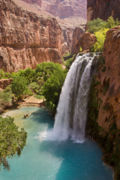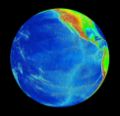Difference between revisions of "Fundamental resources/Water"
(→Abundance of water) |
|||
| Line 24: | Line 24: | ||
[[Image:Pacific Ocean surface.jpg|120px|right|Pacific ocean]] | [[Image:Pacific Ocean surface.jpg|120px|right|Pacific ocean]] | ||
| − | + | Over 70% of the surface of the Earth is covered by water, with the average depth of the oceans being 3.8 kilometres (12,430 ft) - we live on what is primarily a water world. Wasting the fresh water that falls on the surface of the land should of course be avoided wherever possible, but interestingly, having enough fresh water anywhere in the world, ultimately comes down to energy, rather than water itself. | |
| − | As long as we have large amounts of energy (of renewable) at our disposal (which we do), we can always create fresh water as required from seawater, using reverse osmosis | + | As long as we have large amounts of energy (of renewable) at our disposal (which we do - see the [[#Energy|energy section]]), we can always create fresh water as required from seawater, using reverse osmosis or newer more energy-efficient methods. However, being careful with what we already have reduces the energy required for this. |
Revision as of 20:41, 13 June 2010
Water is life. To secure a high standard of living for all people, we must secure an abundant, renewable supply of water for drinking, cleaning, cooking, irrigation, heating and cooling. The purpose of this page is to show how this is possible using currently existing technologies.The intelligent use of mankind's water resources is not just an environmental issue; it is a public health issue. Drinking contaminated water is one of the most common causes of cholera, typhoid, diarrhoea, hepatitis A, dysentery and river blindness. Luckily, there is no need for this to happen, other than scarcity-based economics. We have all the technology to provide abundant pure water for all of humanity.
Sources of clean water
Suspended particles can be removed from water by passing them through a slow sand filter with layers of gravel and sand. This is within the reach of all the World's people, as it requires no input of energy and no technological sophistication. A slow sand filter makes water safer for drinking, but does not fully remove all microscopic pathogens. UV light is a clean and effective way to kill water-borne pathogens and requires no chemicals, only a little electricity. As LEDs get cheaper and more energy-efficient, the use of UV-emitting LEDs to sterilize water becomes more and more attractive. It would be a relatively simple matter to fit homes with the means to catch rainwater, pass it through a slow sand filter and sterilize it with UV light. In many temperate and tropical climates, this would provide the inhabitants of the home with an abundance of water. This decentralization of water-production would eliminate the need for complicated municipal water-distribution systems and would make individuals more independent and resilient in the case of disasters.
The Watermill is an invention that condenses water from the air. This water is clean and ready to drink.
Nanofilters are an effective way of filtering out both suspended particles (which cause unpleasant tastes, smells and discoloration) and pathogens. The Tata Swach is a device that uses nanofilters to give very pure water. It retails for only $21. However, like other filters, it eventually clogs with impurities.
Filters made of carbon nanotubes, small enough to let water molecules pass though, while blocking salt particles, impurites and pathogens, have recently reduced the price of desalination of sea water by 75% [1]. As 97% of the world's water is in the oceans, and unsalted water is needed for most human purposes, a practical method of desalination is a huge key to making Spaceship Earth work for all its inhabitants. IBM are conducting research into nanofiltration-based desalination [2]. Filtration using nanotubes that are too small to become clogged is being investigated [3].
Using less water
In the USA in 2006, the average water use per person per day was 575 litres. Compare this with 149 litres in the UK and 4 litres in Mozambique. Peter Gleick has said that 50 litres of water is sufficient for a person[4].
Using composting toilets rather than flush toilets would save 26.7%[5] of water use in the home. Composting toilets are also a source of fertilizer for growing food - and electrodes could even harvest electricity from the bacteria they contain (see Energy).
With the concern about conserving water in recent years, designers have developed toilets, sinks, dishwashers and washing machines that use a fraction of the water used by conventional designs.
However, reducing the domestic use of water is only a small part of the puzzle. 69% of water used by humans goes towards irrigation for agriculture [6]. A method of agriculture that uses 2% of the water of drip irrigation is discussed in the page about food.
Abundance of water
Over 70% of the surface of the Earth is covered by water, with the average depth of the oceans being 3.8 kilometres (12,430 ft) - we live on what is primarily a water world. Wasting the fresh water that falls on the surface of the land should of course be avoided wherever possible, but interestingly, having enough fresh water anywhere in the world, ultimately comes down to energy, rather than water itself.
As long as we have large amounts of energy (of renewable) at our disposal (which we do - see the energy section), we can always create fresh water as required from seawater, using reverse osmosis or newer more energy-efficient methods. However, being careful with what we already have reduces the energy required for this.

